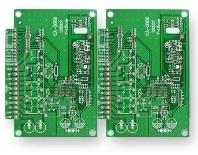Single-sided paper substrates with a large number of holes and complex shapes and epoxy glass cloth substrates with double-sided non-metallized holes.
Punching: Large production batches. Usually one or several sets of dies are used for punching.
Shape processing: Printed boards produce large-volume single-sided and double-sided shapes, usually using die punching. According to the size of the printed board, it can be divided into upper blanking die and falling material die.
Composite processing: The holes and the holes of the printed board, and the holes and the shape require high precision. At the same time, in order to shorten the manufacturing cycle and improve the productivity, the composite mold is used to process the holes and the shape of the single panel at the same time. The key to processing printed boards with molds is the design and processing of molds, which require professional technical knowledge. In addition, mold installation and debugging are also very important. At present, most of the molds in PCB manufacturing plants are processed by outside factories.

Precautions for mold installation:
Choose the punch (including type, tonnage) according to the punching force calculated by the mold design, the size of the mold, the closing height, etc.
Turn on the punch, and comprehensively check whether the clutch, brake, slider and other parts are normal, whether the operating mechanism is reliable, and there is no continuous punching phenomenon.
The shim under the die is usually 2 pieces, which must be ground on the grinder at the same time to ensure that the die is installed parallel and vertical. The leap position of the shim does not hinder the blanking and at the same time, it should be as close as possible to the center of the mold.
Several sets of pressure plates and T-head pressure plate screws should be prepared for corresponding use with the mold. The front end of the pressure plate cannot touch the straight wall of the lower mold. Emery cloth should be placed between the contact surfaces, and the screws must be tightened.
When installing the mold, pay great attention to the screws and nuts on the lower mold not to touch the upper mold (the upper mold is lowered and closed)
When adjusting the mold, use manual as much as possible instead of maneuvering.
In order to improve the punching performance of the substrate, the paper substrate must be preheated. The temperature is preferably 70 90 degree Celsius.
The quality defects of the hole and shape of the printed board punched by the die are as follows: the periphery of the hole is raised or the copper foil is warped or layered; there is a crack between the hole and the hole; the hole position is not vertical or the hole itself is not vertical; The burr is large; the section is rough; the punched printed circuit board is warped in the shape of the bottom of the pot; the waste material jumps up; the waste material is blocked. The inspection and analysis steps are as follows: check whether the punching force and rigidity of the punch are sufficient; whether the mold design is reasonable and whether the rigidity is sufficient; whether the processing accuracy of the convex and concave molds and the guide posts and guide sleeves is concentric and vertical. Whether the fit clearance is uniform. If the gap between convex and concave is too small or too large, it will produce quality defects, which is the most important problem in mold design, processing, debugging, and use. The edges of convex and concave molds are not allowed to be rounded or chamfered. The punch is not allowed to have taper, especially when punching, whether it is a positive cone or an inverted cone. During production, pay attention to whether the cutting edges of convex and concave molds are worn. Whether the discharge port is reasonable and the resistance is small. Whether the pushing plate and the punching rod are reasonable and the force is sufficient. The thickness of the sheet to be punched and the bonding force of the substrate, the amount of glue, the bonding force with the copper foil, preheating humidity and time are also factors to be considered in the analysis of punching quality defects.
Hole and shape processing can be used die punching method, printed board blanking. For PCBs that are simple to process or PCBs that are not very demanding, blanking can be used. It is suitable for low-level and high-volume PCBs with low requirements and PCB production with low profile requirements, and its cost is low.